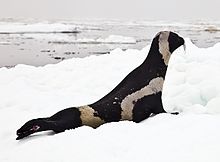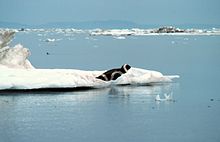Ribbon seal
| Ribbon seal[1] | |
|---|---|

| |
| Scientific classification | |
| Domain: | Eukaryota |
| Kingdom: | Animalia |
| Phylum: | Chordata |
| Class: | Mammalia |
| Order: | Carnivora |
| Clade: | Pinnipedia |
| Family: | Phocidae |
| Genus: | Histriophoca Gill, 1873 |
| Species: | H. fasciata
|
| Binomial name | |
| Histriophoca fasciata (Zimmermann,1783)
| |

| |
| Ribbon seal range (blue – summer, pink – maximal) | |
Theribbon seal(Histriophoca fasciata) is a medium-sizedpinnipedfrom thetrue sealfamily (Phocidae). A seasonally ice-bound species, it is found in theArcticandSubarcticregions of theNorth Pacific Ocean,notably in theBering SeaandSea of Okhotsk.It is distinguished by its striking coloration, with two wide white strips and two white circles against dark brown or black fur.
It is the only living species in the genusHistriophoca,[1]although a possible fossil species,H. alekseevi,has been described from the Miocene ofMoldova.[3]
Description[edit]

Adult seals are recognizable by their black skin, which carries four white markings: a strip around the neck, one around the tail and a circular marking on each body side,[4]which encloses the front fins. The contrast is particularly strong with the males, while with females the difference in color between bright and dark portions is often less conspicuous. Newborn ribbon seal pups have whitenatal fur.Aftermoultingtheir natal fur, their color changes to blue-grey on their backs and silvery beneath. Over the course of three years, portions of the fur become darker and others brighter after every molt, and only at the age of four years does the striped pattern emerge.[5]
The ribbon seal has a short snout with broad, deep internalnaresand large, rounded, front-facingorbits.[6]Like other phocids, it possesses enlargedauditory bullaeand lacks asagittal crest.[6]The ribbon seal has curved, widely spaced dentition and smaller canines than other phocid species.[6]
The ribbon seal has a largeinflatableair sacthat is connected to thetracheaand extends on the right side over the ribs. It is larger in males than in females, and it is thought that it is used to produceunderwatervocalizations,perhaps for attracting amate.[citation needed]Unlike other pinnipeds, the ribbon seal lacks the lobes that divide the lungs into smaller compartments.[7]The ribbon seal can grow to a length of about 1.6 m (5.2 ft) and a weight of 95 kg (209 lb), with males being larger than females.
The main predators of ribbon seals includegreat white sharksandorcas.[8]
Sexual dimorphism[edit]
Male ribbon seals are typically larger than females. This is particularly recognizable in their skull morphology because malenaresopenings are much larger than female nares openings.[6]Larger males are hypothesized to have a better chance of reproducing with multiple females. They have a higherfitnesslevel and win in competition with other males over females.[9]
Habitat[edit]
The ribbon seal lives in the Arctic parts of thePacific Ocean.During winter and spring, ithauls outonpack icetobreed,molt,and give birth. During this time, it is found at theice frontin theBeringandOkhotskSeas.[10]During the winter and spring, the ribbon seal lives in open water, though some move south as theicerecedes with warmer temperatures. Little is known about its habit during this time, as it is so far from land and human observation. The ribbon seal almost always comes to land.
Thus far, there have been three acknowledged instances where ribbon seals have been found as far south asSquamish, British Columbia,Long Beach, Washington,and even further south atMorro Bay, California.There was nothing to suggest that illness was the cause of the seals appearance, as they appeared to be healthy.[11][12]
Behavior[edit]
Ribbon seals are rarely seen out on the ice and snow. Their method of movement on the ice is highly specialized. While quickly undulating their body in serpentine motion, they grip into the ice with their claws and use alternating flipper strokes to pull themselves across the ice's surface. It has been observed that this form of locomotion is rendered ineffective on other surfaces, most likely due to the increased friction between the animal's fur and the substrate.[5]
While out on the ice, ribbon seals are noticeably indifferent to their surroundings. Humans in boats have been able to closely approach these seals before disturbing them. Mothers have been observed leaving pups by themselves for extended lengths of time. This would suggest that they experience little predation from land predators such as bears or humans, relative to other seals. When these seals are captured in nets, they are known to engage in feigning death behavior.[5]

Diet[edit]
The diet of ribbon seal consists almost exclusively ofpelagiccreatures: fish likepollocks,eelpouts,theArctic cod,andcephalopodssuch assquidandoctopus;young seals eatcrustaceansas well. The ribbon seal dives to depths of up to 200 m in search of food; it issolitaryand forms no herds.
Ribbon seals located in theBering Seaconsume pollock, eelpout, and arctic cod.[13]Adult seals have relatively weak and smooth canines because their food does not need to be viciously torn.[14]
Reproduction[edit]
Ribbon seals have apolygynousmating system, where males mate with multiple females. Ribbon seals mate and give birth on pack ice rookeries, sea ice that is not connected to land. Males use vocalizations to defend breeding territories or to attract mates.[15]Males become sexually mature at three to six years old, females become sexually mature between two and five years old.[16]Breeding occurs once annually, and takes place usually in late May to June, corresponding to the loss of sea ice in spring.[16]
After mating, the embryo does not implant directly after fertilization, instead it hasdelayed implantationfor approximately two to four months.[16]Delayed implantation allows the female to give birth when sea ice extent is greatest.[17]Pregnant females have a gestation of approximately ten to eleven months,[17]and give birth to one pup. Females care for their pup on pack ice for approximately four to six weeks.[17]The milk females provide their pup is high in proteins and lipids, which allows the pup to grow very quickly.[15]While lactating, a female ribbon seal will not forage for food, but must rely on fat stores in her body.[15][17]After weaning the pup the female will teach the pup how to dive to forage for prey.[15][17]
Seal pups are born with a whitelanugo(fur coat) that is shed about a month after birth. These pups do not enter the water until their lanugo is completely gone because their layer ofblubber,and protection from cold ocean temperatures, remains undeveloped until shedding. Young ribbon seals were over hunted because of their soft and dense fur coat, which caused the population to decline.[8]
Protection[edit]
Young ribbon seals look like youngharp seals,and like these, they were hunted for their fur. Since they do not form herds, ribbon seals were more difficult to catch than harp seals. Since theSoviet Unionlimited the hunt on ribbon seals in 1969, their population has recovered. The current population is around 250,000.

In March 2008 the US government agreed to study Alaska's ribbon seal population and considered adding it to the endangered species list. However, in December 2008, the US government decided that sea ice critical to the seals' survival will not be endangered byglobal warming,and declined to list the species.[18][5]Instead, it became a U.S. National Marine Fisheries ServiceSpecies of Concern.The US Government'sNational Oceanic and Atmospheric Administration,National Marine Fisheries Service(NMFS), has some concerns regarding status and threats of some species, for which insufficient information is available to list them under the USEndangered Species Act.
In the summer of 2009 theCenter for Biological Diversityfiled suit to get the decision changed.On July 10, 2013, after again reviewing the status of this species, theNational Marine Fisheries Servicefound that listing under the ESA was not warranted.[19]
See also[edit]
References[edit]
- ^abWozencraft, W. C.(2005)."Order Carnivora".InWilson, D. E.;Reeder, D. M. (eds.).Mammal Species of the World: A Taxonomic and Geographic Reference(3rd ed.). Johns Hopkins University Press.ISBN978-0-8018-8221-0.OCLC62265494.
- ^Lowry, L. (2016).Histriophoca fasciata.The IUCN Red List of Threatened Speciesdoi:10.2305/IUCN.UK.2016-1.RLTS.T41670A45230946.en
- ^Berta, A. & Churchill, M. (2012). "Pinniped Taxonomy: evidence for species and subspecies".Mammal Review.42(3): 207–234.doi:10.1111/j.1365-2907.2011.00193.x.
- ^Saundry, Peter (2010).Ribbon seal.Encyclopedia of Earth. C.Michael Hogan (Topic Editor). Cutler J. Cleveland, ed. National Council for Science and the Environment, Washington DC
- ^abcdBoveng, P.L. et al. (2008).Status Review of the Ribbon Seal (Histriophoca fasciata).Seattle, WA:U.S. Dept. of Commerce,National Oceanic and Atmospheric Administration,National Marine Fisheries Service,Alaska Fisheries Science Center.
- ^abcdBurns, John J.; Fay, Francis H. (2010-05-06). "Comparative morphology of the skull of the Ribbon seal, Histriophoca fasciata, with remarks on systematics of Phocidae".Journal of Zoology.161(3): 363–394.doi:10.1111/j.1469-7998.1970.tb04519.x.ISSN0952-8369.
- ^"Histriophoca fasciata (ribbon seal)".Animal Diversity Web.Retrieved2018-06-06.
- ^abBurns, John J. (1970). "Remarks on the Distribution and Natural History of Pagophilic Pinnipeds in the Bering and Chukchi Seas".Journal of Mammalogy.51(3): 445–454.doi:10.2307/1378386.JSTOR1378386.
- ^Shine, Richard (December 1989). "Ecological Causes for the Evolution of Sexual Dimorphism: A Review of the Evidence".The Quarterly Review of Biology.64(4): 419–461.doi:10.1086/416458.ISSN0033-5770.PMID2697022.S2CID46445815.
- ^SCS: Ribbon Seal (Phoca fasciata).pinnipeds.org
- ^Rare sea creature appears on Seattle woman's dock.LiveScience via Yahoo News(January 21, 2012)
- ^"Rare Arctic ribbon seal observed near Surfside".Chinook Observer. August 18, 2016.
- ^Frost, Kathryn J.; Lowry, Lloyd F. (September 1980). "Feeding of ribbon seals (Phoca fasciata) in the Bering Sea in spring".Canadian Journal of Zoology.58(9): 1601–1607.doi:10.1139/z80-219.ISSN0008-4301.
- ^SCHEFFER, VICTOR B. (2009-08-20). "Dentition of the Ribbon Seal".Proceedings of the Zoological Society of London.135(4): 579–585.doi:10.1111/j.1469-7998.1960.tb05867.x.ISSN0370-2774.
- ^abcdMacdonald, D (2006).The Princeton Encyclopedia of Mammals.Vol. 1. Princeton, NJ: Princeton University Press. pp. 520–544.
- ^abcAtkinson, S. (1997)."Reproductive biology of seals"(PDF).Reviews of Reproduction.2(3): 175–194.doi:10.1530/ror.0.0020175.ISSN1359-6004.PMID9414481.
- ^abcdeFedoseev, G (2002).Encyclopedia of Marine Mammals.Vol. 1 (1 ed.). San Diego, CA: Academic Press. pp. 1027–1033.
- ^Govt: Ribbon seals not endangered.Associated Press. 23 December 2008
- ^NMFS (July 10, 2013)."Endangered and Threatened Wildlife; Determination on Whether To List the Ribbon Seal as a Threatened or Endangered Species"(PDF).Federal Register.78:41371–41384.
External links[edit]
- Overview pages on ribbon seals (Histriophoca fasciata) hosted by:
- Range map onOBIS*SEAMAP
- Voices in the Sea – Sounds of the Ribbon Seal





